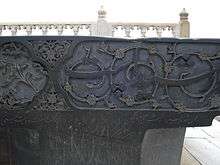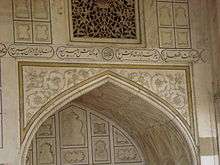Persian language in the Indian subcontinent
The Persian language in the Indian subcontinent, before the British colonized the Indian subcontinent, was the region's lingua franca and a widely used official language in north India. The language was brought into the Indian subcontinent by various Turkic and Afghan dynasties, in particular the Turko-Afghan Delhi Sultanate and the Mughal Dynasty. Persian held official status in the court and the administration within these empires and it heavily influenced many of the local languages, particularly modern standard Hindi and modern standard Urdu.
Evidence of Persian's historical influence there can be seen in the extent of its influence on the languages of the Indian subcontinent. Many of these areas have seen a certain influence by Persian not only in literature but also in the speech of the common man. Persian exerted a strong influence on Balochi (an Iranian language) and Urdu, and a relatively strong influence on Pashto (another Iranian language), Punjabi and Sindhi. Other languages like Hindi, Marathi, Gujarati, Rajasthani and Bengali also have a considerable amount of loan words from Persian.
Persian's official status was replaced with English in 1835 by British East India Company. After 1843, Hindustani and English gradually replaced Persian in importance in the Indian subcontinent as the British had full suzerainty over the Indian subcontinent.[1]
Persian inscriptions
The basis for the introduction of Persian language into the Indian subcontinent was set, from its earliest days, by various Persianized Central Asian Turkic and Afghan dynasties.[2] Thus, when the early Turks, Afghans, and Turko-Persians imported the language to the Indian subcontinent, they laid the basis for its patronisation in the centuries to come, notably by the Delhi Sultanate (who were once again of Turko-Afghan origin) and the Mughals (who were of Turko-Mongol origin). There are many stone carvings and plasters of Persian inscriptions in India. There are also many handwritten books mostly from the time of Humayun, a Mughal emperor who had heavy admiration for anything West Asian, and Persian in particular. Humayun lost Mughal territories to the Pashtun noble, Sher Shah Suri, but, with the aid of the powerful West Asian Safavids, regained them 15 years later. Humayun's return from Persia, accompanied by a large retinue of Persian noblemen, signaled an important change in Mughal court culture, as the Central Asian origins of the dynasty were largely overshadowed by the influences of Persian art, architecture, language, and literature. There are many carved stones and Persian manuscripts in the Indian subcontinent from the time of Humayun.
Subsequently, in a very short time, Humayun was able to expand the Empire further, leaving a substantial legacy for his son, Akbar. His peaceful personality, patience, and non-provocative methods of speech earned him the title Insan-i Kamil (انسان کامل), meaning literally perfect man, among the Mughals.[3]
See also
- Persian Inscriptions on Indian Monuments (book)
- Persian and Urdu
Gallery


 Calligraphy of Persian poems (18th century)
Calligraphy of Persian poems (18th century) Persian poem
Persian poem Persian inscription
Persian inscription Persian poem
Persian poem Arjomand Banou
Arjomand Banou
References
- Clawson, Patrick (2004). Eternal Iran. Palgrave Macmillan. p. 6. ISBN 1-4039-6276-6.
- Sigfried J. de Laet. History of Humanity: From the seventh to the sixteenth century UNESCO, 1994. ISBN 9231028138 p 734
- Mughal-Ottoman relations: a study of political & diplomatic relations ... - Naimur Rahman Farooqi - Google Boeken. Books.google.com. Retrieved 2012-08-14.
Further reading
- Chopra, R. M., The Rise, Growth And Decline of Indo-Persian Literature, Iran Culture House, New Delhi, 2012.
Sources
- "History of Persian or Parsi Language" — Iran Chamber Society
- — soas.ac.uk
- Catalogue of Persian manuscripts in the library of the India office, Volume 1 (1903)